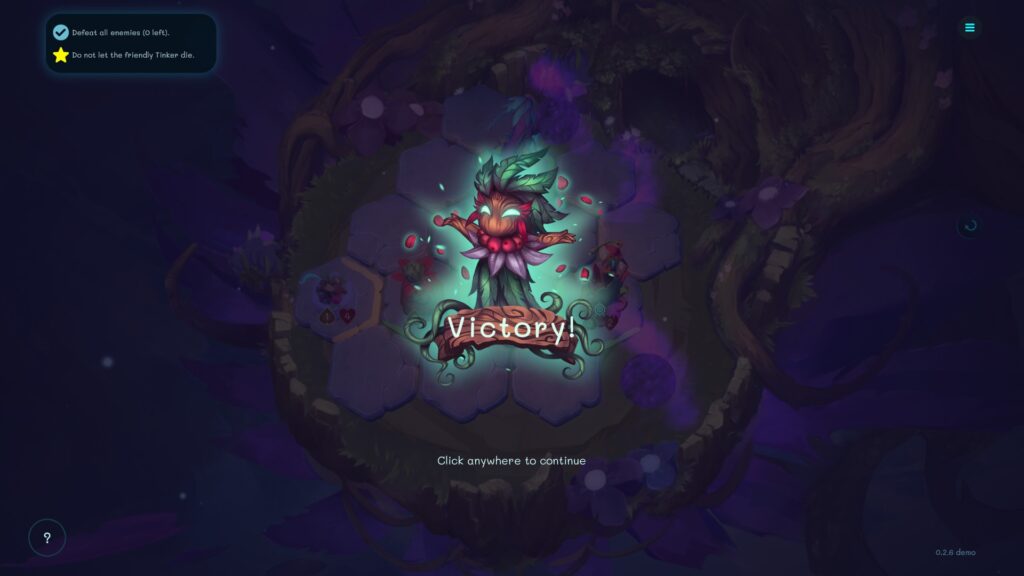Now here is a pretty game. Oaken, the hex-based roguelike of battling nature spirits by Laki Studios, has some of the best visuals among all the titles being featured in Steam Next Fest this week. If you’re looking for a game to take you away to a fantasy realm, this is a great choice.
The spirits that surround the Great Oak have existed in harmony for an unknown – but very long – amount of time. The sudden silencing of the Oak Song that binds them, however, has caused chaos and dissonance turning some spirits wild, feral, and aggressive. As a heroic nature spirit assisted by a Guide, you’ll summon friendly beings to your side and use your magic to cleanse the Great Oak and restore the balance.
Gameplay

Traversing the Great Oak is divided into several chapters, with a boss fight at the end of each. You’ll have to choose your path along the way, finding events and battles based on your decisions. The most common nodes are of course battles, sometimes against elite monsters, but occasionally you’ll get an event that allows you to earn upgrades or heal up.
The battles, all of which are reasonably short, play like Hearthstone on a hex map. At the start of each encounter only your Hero will be on the board (in the Next Fest demo only one Hero, the Lady, is available). You have a hand of four cards from your deck, which consist of allies and spells; as you might expect, allies can be summoned to the board on an empty space up to a short distance from your Hero, and spells provide an immediate effect once.
While the mana costs on the individual cards are fairly generous (in the demo version, at least), playing cards too aggressively can hamper your run. The first time you play a card during a battle, it cycles back into your deck. The next time you draw that copy of the card, it is considered Unstable – denoted by the card’s image being distorted. If you play an Unstable card, it becomes unusable for the remainder of the chapter. This means that in most cases the best time to go all-in and play your Unstable cards is during a boss fight since they’ll be back afterward as long as you win.

Beyond your small deck, you’ll also have access to a trio of abilities unique to your run. Two come from your Hero, and the third is provided by your chosen Guide (see below). These are essentially spells that can be cast once per turn as long as you have the mana. They don’t go into your deck, and they don’t become Unstable, allowing you to always have some tricks at your disposal.
Possibly more important than your choice of Hero is the Guide you select at the beginning of the run. Only two are available in the demo version, but the silhouettes on the selection screen seem to indicate there will be eight in the final cut of the game. Your Guide is a powerful ally who exists outside of your hand, similar to a Commander in Magic. They tend to have a high mana cost but clutch abilities. Furthermore, your chosen Guide provides you with a trinket, a global power that is always active. Building your deck and strategy around your trinket looks to be a major part of winning a run.
While the battlefields of Oaken are small, there’s usually quite a lot going on. Most maps will see enemies constantly spawning from all directions, with only one turn’s notice. Success in combat requires much more than just having the right units positioned in the right place; the game also uses a system by which tiles can be claimed by either side. Green tiles are cleansed of corruption, while dark purple tiles have fully turned to Dusk. Many abilities can cause the colors of tiles to rapidly change back and forth, and you’ll need to be aware of their status at all times.
Enemies often get bonuses on Dusk tiles, turning weak foes into dangerous ones and dangerous foes into lethal threats. Conversely, there are plenty of units available to your Hero who gain benefits from being on green tiles. Aya, one of the demo guides, provides a trinket that deals 1 damage to all enemies standing on a green tile at the end of your turn, which is extremely potent if used well.

Combat is fast and deadly in Oaken. Most units on either side have few hit points, meaning they’ll only be able to survive one or two scrapes before falling. If you can manage to get a unit to attack an enemy from behind, they’ll be safe from retaliation, but the close quarters and restrictive movement rules make this easier said than done. While you aren’t likely to be outnumbered at any given time unless things go very wrong, you’ll have to get more net kills than your opponent over the course of each fight – the foes will keep spawning until they run out, while you’re limited to what’s in your deck.
Once all the enemies on a map have spawned, your Hero will begin to take Fatigue each turn, requiring you to wrap things up in a timely manner. Fatigue reduces your Hero’s maximum hit points. It’s removed after winning a boss fight, and there are a few events that allow you to clear a small amount of Fatigue, but in most cases, once it’s accrued you’re stuck with it for the chapter. Some enemy attacks can also inflict Fatigue, potentially diminishing your allies and Guide as well.

As you progress along the map, you’ll find Wisps and Lumi. Wisps are upgrades that can be assigned to a specific card, giving them new abilities. This is a great way to develop your build and gain synergies; for example, the Seedling is a unit that turns nearby spaces green when it is summoned. With the right Wisp, it can also heal nearby allies upon arrival as well, letting you get more value for your card.
Lumi, on the other hand, are spent to directly empower cards. Spending Lumi increases the attack or HP of a card permanently. This is limited specifically to the copy of the card you spent the Lumi on, so at the end of long runs, it’s entirely possible to have two different copies of the same card that act very differently when played.
Like most roguelikes, Oaken is fairly challenging even on its standard difficulty setting. Getting your Hero caught out of position can end a run very quickly. Unlike other games in the genre, however, Oaken mercifully grants you exactly one continue per run – chances are, you’ll need it.
Graphics & Sound

Just look at the screenshots – this game is gorgeous. The character designs all fit perfectly with the setting and theme, with contrasting colors that give the whole thing its natural, otherworldly look. The UI is easy to understand, and once you know what each card does it’s easy to assess your hand with a quick look at the illustrations.
The soundtrack is equally lovely, with folk elements that are perfect for the fantasy world the devs have created. No game can be judged solely on its presentation, but in that regard, Oaken deserves top marks.
Overall

While the demo version is just a taste of the full game, it’s a taste that leaves us wanting another serving. There’s a lot more game to explore, and we’re very curious to see what other content the game offers. Even if you’re more of a card player than a tactical gamer, there’s a lot to like here – Oaken’s blending of genres in a distinct, wonderfully-presented package has much to offer. We look forward to the full version later this year.







